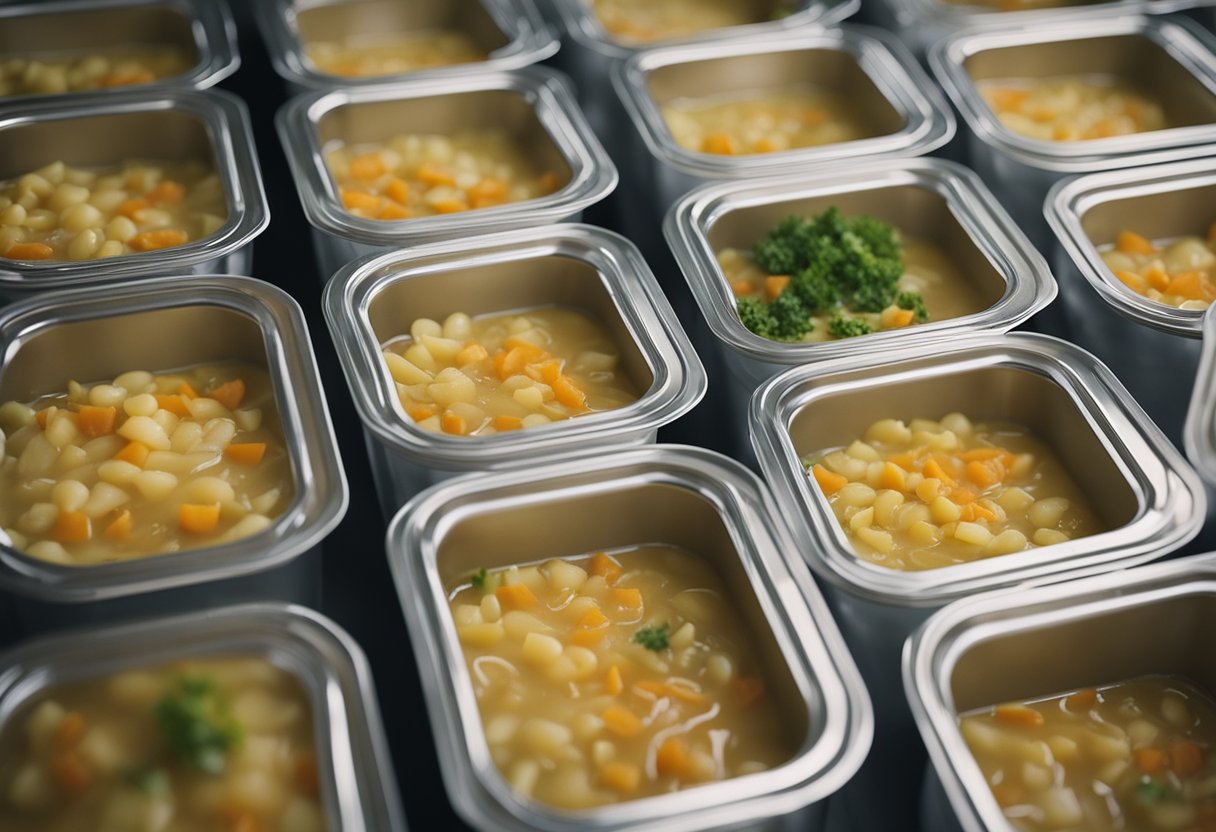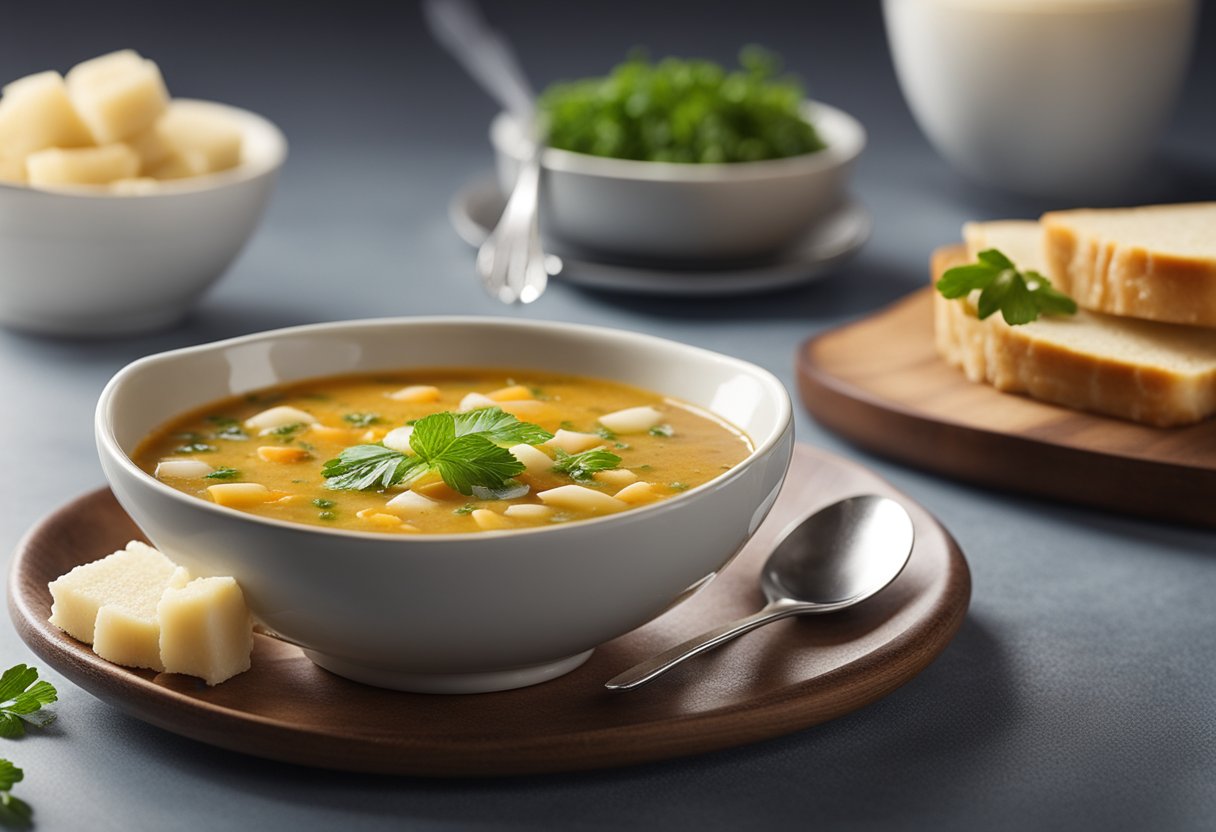Freezing soup in individual portions is a great way to save time and effort in the kitchen. It’s a convenient option for busy individuals who want to have a quick and easy meal on hand. By freezing soup in individual portions, you can avoid wasting food and save money in the long run.

Understanding the basics of freezing soup is essential for maintaining its quality. Choosing the right soup for freezing is important, as some soups freeze better than others.
Preparation before freezing is also key, including cooling the soup to room temperature and selecting the right freezing containers. Properly freezing the soup is crucial to avoid freezer burn and maintain its taste and texture.
Thawing and reheating the soup requires careful attention to ensure that it is safe to eat and retains its quality. Tips to maintain soup quality and avoid common freezing mistakes can also help you make the most of your frozen soup.
Key Takeaways
- Freezing soup in individual portions is a convenient option for busy individuals.
- Understanding the basics of freezing soup, including selecting the right soup, preparation, and proper freezing techniques, is essential for maintaining quality.
- Thawing and reheating soup requires careful attention to ensure safety and quality.
Understanding the Basics of Freezing Soup
As someone who loves homemade soup, I find it incredibly convenient to freeze it in individual portions. This way, I can easily heat up just the right amount whenever I’m in the mood for some comfort food. Here are some basics to keep in mind when freezing soup:
Choosing the Right Containers
When it comes to freezing soup, you want to make sure you’re using containers that are freezer-safe. Glass containers are great because they don’t absorb odors or stains, and they can go straight from the freezer to the microwave or oven.
Plastic containers are also an option, but make sure they’re labeled as freezer-safe and can withstand the cold temperatures.
Another thing to keep in mind is portion size. Freezing soup in individual portions is ideal because it allows for easy reheating and reduces waste. I usually aim for 1-2 cup portions, depending on how much soup I have.
Preparing the Soup for Freezing
Before freezing your soup, make sure it’s cooled down to room temperature. This not only prevents the freezer from working overtime, but it also prevents the soup from developing ice crystals. Once cooled, ladle the soup into your chosen containers, leaving some room at the top for expansion.
If you’re using plastic containers, consider placing a layer of plastic wrap directly on top of the soup before sealing the lid. This will help prevent freezer burn and keep the soup fresh.
Storing and Reheating Frozen Soup
Frozen soup can last up to 3 months in the freezer, but it’s best to use it within 1-2 months for optimal quality.
When you’re ready to enjoy your frozen soup, simply remove it from the freezer and let it thaw in the fridge overnight. Alternatively, you can microwave it on the defrost setting or heat it up on the stove over low heat.
One thing to keep in mind is that some soups may separate or change texture after being frozen. Cream-based soups, for example, may become grainy or curdled. To prevent this, consider adding the dairy component after reheating the soup.
By following these basic guidelines, you can enjoy homemade soup anytime without the hassle of making it from scratch every time.
Choosing the Right Soup for Freezing

When it comes to freezing soup in individual portions, not all soups are created equal. Some soups freeze better than others, and it’s important to choose the right soup recipe if you want to ensure that your frozen soup tastes just as good as it did when it was first made.
Here are some things to keep in mind when choosing a soup recipe to freeze:
Broth-Based Soups
Soups that are primarily broth-based, such as chicken noodle soup or vegetable soup, tend to freeze well. The broth helps to preserve the flavor and texture of the soup, and the vegetables and grains in the soup hold up well to freezing.
Creamy Soups
Creamy soups, such as potato soup or chowder, can be a bit trickier to freeze. The dairy in the soup can separate when frozen and thawed, resulting in a grainy or curdled texture.
If you want to freeze a creamy soup, consider leaving out the dairy and adding it in when you reheat the soup.
Stews
Stews, such as beef stew or lentil stew, are another good option for freezing. The hearty ingredients in stews hold up well to freezing, and the flavors tend to meld together even more when the stew is reheated.
Chili
Chili is another great option for freezing. The spices and flavors in chili tend to become more complex and delicious when the chili is reheated, making it a perfect meal to freeze and enjoy later.
Grains
Soups that contain grains, such as barley or minestrone, also tend to freeze well. The grains hold up well to freezing and thawing, and they add a nice texture to the soup.
Overall, when choosing a soup recipe to freeze, it’s important to consider the ingredients and how they will hold up to freezing. Stick to broth-based soups, stews, chili, and soups with grains for the best results.
Avoid creamy soups or consider leaving out the dairy if you want to freeze them. With the right soup recipe, you can enjoy a cozy bowl of soup even on the busiest of days.
Preparation Before Freezing

Before freezing your soup in individual portions, there are a few things to keep in mind to ensure that your soup will freeze and reheat properly.
Cool the Soup
First and foremost, make sure that your soup has cooled down to room temperature before freezing. Putting hot soup into the freezer can cause the liquids to expand and potentially break your containers or jars. It can also cause other foods in your freezer to thaw and spoil.
Separate Into Portions
Next, decide how you want to portion your soup. You can use silicone muffin cups, plastic bags, or glass jars. Whatever you choose, make sure that the portions are appropriate for your needs.
If you’re freezing soup for a family of four, you might want to use quart-sized bags or jars. If you’re freezing soup for one or two people, silicone muffin cups or pint-sized jars might be more appropriate.
Avoid Pasta and Rice
If your soup contains pasta or rice, consider leaving them out and cooking them fresh when you reheat your soup. Pasta and rice can become mushy and overcooked when frozen and reheated. Instead, focus on freezing the broth and vegetables separately.
Use a Ladle
When filling your containers or jars, use a ladle to transfer the soup. This will help you avoid spills and messes. If you’re using glass jars, make sure that you leave enough headspace at the top to allow for the liquids to expand when frozen.
Label and Date
Finally, label your containers or jars with the name of the soup and the date that you froze it. This will help you keep track of what you have in your freezer and ensure that you use your soup before it goes bad.
By following these simple steps, you can prepare your soup for freezing and ensure that it will be just as delicious when you reheat it later.
Choosing the Right Freezing Containers
When it comes to freezing soup in individual portions, choosing the right container is crucial. Here are some factors to consider when selecting the best freezing containers:
Material
The most common materials for freezing containers are plastic and glass. Plastic containers are generally more affordable and lightweight, but they can absorb odors and stains over time. Glass containers are more durable and can be reused many times, but they are heavier and more expensive.
Size
The size of the container should match the amount of soup you want to freeze. A muffin tin can be a great option for freezing individual portions of soup. For larger batches, consider using gallon-sized bags or quart-size freezer bags.
Airtightness
Make sure the container you choose is airtight to prevent freezer burn and keep your soup fresh. Zip-top plastic freezer bags and airtight containers are good options for this.
Shape
Consider the shape of the container when choosing the best option for freezing soup. Shallow containers or ice cube trays are great for freezing small portions of soup, while tall containers are better for larger batches.
Freezer-Safe
Make sure the container you choose is freezer-safe. Not all plastic containers are safe for freezing, so be sure to check the label before using them.
In summary, when choosing the right freezing containers for soup, consider the material, size, airtightness, shape, and freezer-safety. By taking these factors into account, you can ensure that your soup stays fresh and delicious when frozen in individual portions.
Properly Freezing the Soup
When it comes to freezing soup, there are a few key steps to ensure that it stays fresh and delicious for up to three months. Here’s how I do it in my test kitchen:
- Cool the Soup: Before freezing your soup, you need to let it cool to room temperature. This helps prevent the liquids from expanding and cracking your freezer-safe containers. I usually let my soup cool for about an hour on the counter before moving it to the fridge.
- Separate into Individual Portions: One of the best ways to freeze soup is in individual portions. This makes it easy to defrost and reheat exactly what you need, without having to thaw an entire container. I recommend using Souper Cubes® to freeze individual portions of soup. They are freezer-safe, airtight containers with a flexible silicone lid that allows you to easily pop out the frozen soup.
- Label and Freeze: Once you’ve portioned your soup, label each container with the type of soup and the date you froze it. This will help you keep track of what’s in your freezer and when it needs to be used. Then, place the containers in the freezer and let them freeze completely.
- Avoid Freezer Burn: Freezer burn can happen when moisture is lost from frozen food, causing it to become dry and tough. To avoid freezer burn, make sure your containers are airtight and don’t leave any extra space at the top. You can also wrap the containers in plastic wrap or aluminum foil for extra protection.
By following these steps, you can ensure that your soup stays fresh and delicious for up to three months in the freezer. When you’re ready to enjoy it, simply defrost in the fridge overnight and reheat on the stove or in the microwave.
Thawing and Reheating the Soup
Once you’re ready to enjoy your frozen soup, you’ll need to thaw and reheat it properly to ensure it’s safe and delicious. Here are some tips for thawing and reheating soup:
Thawing Frozen Soup
The best way to thaw frozen soup is to transfer it from the freezer to the refrigerator and let it thaw overnight. If you’re in a hurry, you can also thaw the soup in the microwave or on the stovetop.
To thaw in the microwave, place the frozen soup in a microwave-safe dish and heat on the defrost setting for a few minutes at a time, stirring occasionally, until the soup is completely thawed.
To thaw on the stovetop, place the frozen soup in a pot and heat over low heat, stirring occasionally, until the soup is completely thawed.
Reheating Thawed Soup
Once the soup is thawed, you can reheat it on the stovetop, in the microwave, or using an Instant Pot.
To reheat on the stovetop, place the thawed soup in a pot and heat over medium heat, stirring occasionally, until it’s heated through.
To reheat in the microwave, place the thawed soup in a microwave-safe dish and heat on high for a few minutes, stirring occasionally, until it’s heated through.
To reheat in an Instant Pot, add the thawed soup to the pot and select the “soup” setting. Once the soup is heated through, release the pressure manually or let it naturally release.
Reheating Frozen Soup
If you forgot to thaw your soup ahead of time, you can still reheat it from frozen. The best way to do this is to use the microwave or stovetop.
To reheat frozen soup in the microwave, place the frozen soup in a microwave-safe dish and heat on high for a few minutes at a time, stirring occasionally, until it’s heated through.
To reheat frozen soup on the stovetop, place the frozen soup in a pot and heat over low heat, stirring occasionally, until it’s heated through.
Keep in mind that reheating frozen soup may take longer than reheating thawed soup, so be patient and keep an eye on it to prevent burning or scorching.
Overall, thawing and reheating soup is a simple process that can be done in a variety of ways. Just be sure to follow food safety guidelines and use proper techniques to ensure your soup is safe and delicious.
Tips to Maintain Soup Quality
When it comes to freezing soup in individual portions, there are a few tips that can help maintain the quality of the soup. Here are some things to keep in mind:
Cool the Soup Properly
Before freezing soup, it’s important to cool it down properly. According to Taste of Home, you should cool soup in the fridge for a few hours before transferring it to the freezer. This will help prevent freezer burn and maintain the texture of the soup.
Label and Date the Containers
Labeling and dating the containers is important for two reasons. First, it helps you keep track of what’s in your freezer. Second, it helps you use up the soup before it starts to lose its quality. According to Food Safety, soup can be stored in the freezer for up to three months.
Use Freezer-Safe Containers
When freezing soup, it’s important to use freezer-safe containers. Plastic containers or bags that are not freezer-safe can cause the soup to become mushy and lose its texture.
Glass containers can be a good option, but make sure to leave some room at the top for the soup to expand as it freezes.
Choose the Best Way to Freeze Soup
There are a few different ways to freeze soup, but some methods are better than others. According to Taste of Home, the best way to freeze soup is to use individual portions in freezer-safe containers. This allows you to thaw only what you need and helps maintain the quality of the soup.
Consider the Type of Soup
The type of soup you are freezing can also impact its quality. For example, soups with noodles or pasta may not freeze as well as soups without. If you are freezing a soup with noodles, consider cooking the noodles separately and adding them to the soup when you reheat it.
Overall, these tips can help you maintain the quality of your soup when freezing it in individual portions.
By taking the time to cool the soup properly, label and date the containers, use freezer-safe containers, choose the best way to freeze soup, and consider the type of soup, you can enjoy delicious soup even after it’s been frozen.
Avoiding Common Freezing Mistakes

When it comes to freezing soup in individual portions, there are some common mistakes that can affect the texture and flavor of your soup. Here are some tips to avoid these mistakes and ensure that your soup stays fresh and delicious for up to three months in the freezer.
1. Cool the Soup Completely
One of the most important things to remember when freezing soup is to cool it completely before placing it in the freezer.
If you put hot soup in the freezer, it can cause the temperature in the freezer to rise, which can lead to freezer burn and mushy texture. To cool the soup quickly, you can place the pot in a sink of ice water and stir it occasionally until it reaches room temperature.
2. Use Freezer-Safe Containers
When freezing soup, it’s important to use containers that are specifically designed for the freezer. Avoid using containers that are not freezer-safe, as they may crack or break in the freezer.
You can use plastic containers, glass jars, or freezer bags to store your soup. Make sure to leave some room at the top of the container to allow for expansion as the soup freezes.
3. Label and Date the Containers
To avoid confusion later on, it’s important to label and date each container of soup before placing it in the freezer.
You can write the contents and date on the lid of glass jars, or on the bag or container using a marker. This will help you keep track of how long the soup has been in the freezer and ensure that you use it before it goes bad.
4. Avoid Using Flour or Cornstarch
Using flour or cornstarch to thicken soup can affect the texture of the soup when it’s frozen. The soup may become mushy or grainy when reheated. Instead, try using pureed vegetables or a small amount of cream to thicken the soup.
5. Freeze in Single Servings
Freezing soup in single servings can make it easier to reheat and serve later on. You can use muffin tins to freeze individual portions of soup, or use freezer bags to store single servings.
This way, you can thaw and reheat only what you need, instead of having to thaw and reheat the entire batch of soup.
By following these tips, you can ensure that your soup stays fresh and delicious for up to three months in the freezer.
Frequently Asked Questions
Can you freeze soup that has been in the refrigerator?
Yes, you can freeze soup that has been in the refrigerator. However, it is important to cool the soup to room temperature before freezing. Putting hot soup directly into the freezer can cause the temperature inside the freezer to rise, which can lead to the growth of bacteria.
How to freeze soup without plastic?
If you prefer not to use plastic containers, you can freeze soup in glass jars or metal containers. Make sure to leave enough space at the top of the container for the soup to expand as it freezes. You can also use silicone bags, which are reusable and eco-friendly.
Best soups to freeze?
Soups that freeze well include broth-based soups, vegetable soups, and bean soups. Cream-based soups may separate when frozen and thawed, so they may not be the best option for freezing.
Can I freeze Chicken soup with vegetables?
Yes, you can freeze chicken soup with vegetables. However, some vegetables may become mushy when frozen and thawed, so it is best to avoid adding vegetables like zucchini, squash, and tomatoes. Instead, add these vegetables when reheating the soup.
How to freeze soup in bags?
To freeze soup in bags, first, let the soup cool to room temperature. Then, ladle the soup into a freezer-safe bag, leaving enough space at the top for the soup to expand. Seal the bag and lay it flat in the freezer. Once the soup is frozen, you can stack the bags to save space.
How long can you keep frozen soup in the freezer?
Frozen soup can be kept in the freezer for up to three months. After that, the quality of the soup may begin to deteriorate. To ensure the best quality, label the soup with the date it was frozen and use it within three months.






